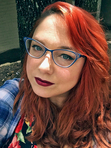E. Kristin Anderson's Blog, page 15
September 26, 2014
Banned Books Month: Guest Post from Lex Hrabe, of the duo Lex Thomas: Write to Get Banned!
Look, banning books is goofy. It’s desperate, medieval thinking, driven by misguided fear. It’s a whole lot of chest-thumping done by outraged parents and administrators trying to keep a tight grip on their jobs. Which, I have to say . . . I totally get. What parent doesn’t harbor some sort of anxiety about how to handle the moment their child gains a full, spotlit awareness of sexuality? And if you were a school administrator, with your plate already full with parental complaints, wouldn’t you, at least for a moment, think, “My day would be a hell of a lot easier if that English class read WHERE THE RED FERN GROWS instead of Sherman Alexie.”
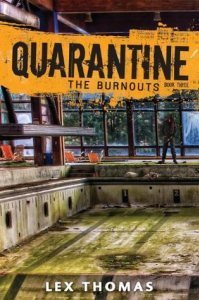
Egmont USA, June 2014.
Here’s the thing — there’s no stopping an idea from catching fire.
Usually, banning a book blows up in a censors’ faces. Sometimes, it doesn’t. But always, it ends up with more kids reading a particular, banned book than ever before. It’s a pretty simple equation. You say, “Whatever you do, don’t look at that. Then I say, “Okay, I won’t,” and I go off and look at it. Why? Because curiosity is a defining trait of humanity (pick any page in a history book for proof).
Kids want to know the truth. Their brains are built to hunt it down. And trying to hide it only makes those hiding it lose credibility. Which brings me to my point — if you write for kids, write to get banned. Even if you’re a parent or a school administrator, once you start a novel, the only thing you should be is a writer. Backlash be damned, your readers are relying on you to tell the truth. And as dangerous as that can feel sometimes, you have a responsibility to pull no punches. You’re not helping anyone by perpetuating cliche or giving soft treatment to real issues. If you feel like you’re writing something dangerous, whether it’s one line of dialogue or every sentence in your book, cling to that feeling. Dare to go there. Because if you don’t, you will change no one’s life. You will influence no one’s thinking. Absolutely no one will love reading because of your book.
It’s nearly impossible to know what’s going to offend someone. The fact that HARRY POTTER has landed on the banned book list is testament to that. So, consider this. If you have the opportunity to break new ground and you do pull your punches, somebody on the internet is still going to be pissed at you for it anyway. Guaranteed. If people are going to be cursing you anyway, wouldn’t you rather have written the book that was in your heart? Why censor yourself when there are plenty of people, ready and willing to do it for you?
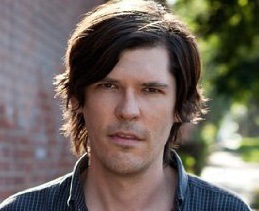
Lex Hrabe.
Lex Thomas is the pen name used by the screenwriting team of Lex Hrabe and Thomas Voorhies. Lex Hrabe was a Drama Geek in high school as well as student body president. Lex received a BA in Drama and English from the University of Virginia and has worn hats as an actor, director, and writer. In addition to working as a screenwriter, he heads development at Cinespire Entertainment, a boutique production company. Lex Hrabe lives in Virginia. You can find Lex Thomas at www.lex-thomas.com





September 25, 2014
Banned Books Month: Guest Post from Ava Dellaira: Dear Banned Authors
Dear F. Scott Fitzgerald, Kate Chopin, Toni Morrison, J.D. Salinger, and Lois Lowry,
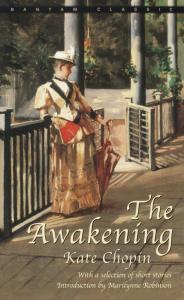
Bantam Classics, Reissue Edition.
I am writing to you because each of you helped me to grow up; you spoke to me when I was on the precipice of adolescence—between who I was and who I was struggling to become. You made me feel not alone, you challenged the limits of my understanding, you made me think, you made me braver. You made my world bigger and helped me to explore my place in it. And you continue to do so. While I may never achieve what you did, each of you made me want to write.
And, I am writing to you now, in celebration of banned books month, because over the years, your books have been frequently challenged or banned, and they continue to be. Those two terms—“celebration” and “banned books” may seem to exist uneasily together in the same sentence, but it’s a testament to those who fight for the value of words that banned books month becomes a time to celebrate our freedom to read.
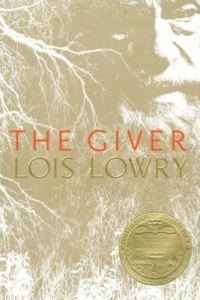
HMH Books for Young Readers, Reprint Edition, July 2014.
We don’t celebrate the bannings—we celebrate those who fight to overcome them, those who stand up for the rights of intellectual freedom, the teachers and parents and librarians who fight to give their kids the right to read the books that might speak to them, that might change their lives. (I discovered each of your books thanks to middle school and high school English teachers, to whom I am deeply grateful.)
And we celebrate you—you who I’ve named here, and all of you—who wrote things that are brave, that are beautiful, that are difficult, that challenge your readers, to take in difficult truths, to find deeper understandings of what it means to be human, to be more aware, to be more consciousness in choosing who we are and who we are becoming.
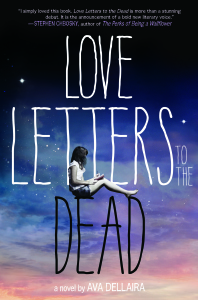
Farrar, Strauss, and Giroux, April 2014.
It’s easy to take our freedoms for granted: among them, our freedom to read, our freedom to write, our freedom to speak our own truths. But those freedoms are not automatic, and books like yours, the very books we honor this month, have helped to make those freedoms possible.
Thank you for the brave things you wrote, the brilliance, the light that you shine. There is unbelievable value in teaching it, in learning it, in taking it in, again and again.
Yours,
A grateful reader
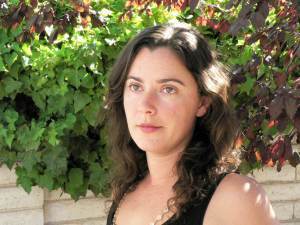
Ava Dellaira. (Photo by Tom Dellaira.)
Ava Dellaira is a graduate of the Iowa Writers’ Workshop, where she was a Truman Capote Fellow. She grew up in Albuquerque, New Mexico, and received her undergraduate degree from the University of Chicago. She currently lives in Santa Monica, where she is at work on her second book.





September 24, 2014
Banned Books Month: Guest Post from Mary Amato: The Sin of Silliness
“Mary Amato, why do you write such silly books?”
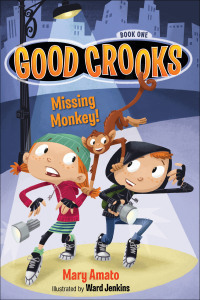
Egmont USA, February 2014.
I was in an elementary school’s library in Illinois, autographing a stack of pre-ordered books after a school wide presentation when the second-grade boy asked me this question. I assumed the boy was there to pick up a book he had ordered and that his question was rhetorical.
As an author, I am invited to schools around the country. Often schools offer sales of my work so that kids can get a signed copy of a favorite title.
“Which book did you order?” I asked.
“I’m not allowed to read your books,” he said.
I dropped my pen. “What?”
“My dad won’t let me,” he said. “They’re too silly. Why do you have to write silly ones? I really want to read one.” He was dead serious.
“Has your dad read my books?” I asked.
“No. He looked at that.” He pointed to the cover of my book SNARF ATTACK on the order form that the librarian had prepared and printed.
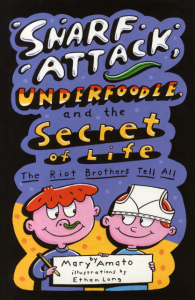
Holiday House, April 2007.
Yes, one boy on the book cover has underpants on his head. Yes, the other one has a green been sticking out of his nostril. Yes, silliness abounds. The series is about two brothers named Orville and Wilbur Riot who have a mission to make something exciting happen every day. They are inventive, curious, funny, and, yes, often silly.
Reluctant readers, kids who find reading to be a chore, or kids who just haven’t found a book that excites them yet often need a heavy dose of humor to pull them in. This alone is reason for me to tap into my inner child when writing for young readers. Often, though, I’m not consciously trying to be funny. I get into character when I am writing, and if the main character happens to be a seven-year-old kid, I just end up saying and doing funny things as that character. I believe children are naturally funny because they see the world through such fresh eyes.
My books aren’t just silly, though. If you get past the cover, you find that Orville and Wilbur are incredibly loving. My inspiration to write the series came from reading a biography about Orville and Wilbur Wright. The Wright Brothers. I learned that as children, the brothers were great, affectionate friends. At the time, I had two sons who happened to be in a bickering stage. Lots of books they were reading emphasized and exploited sibling rivalry. I consciously created big, loving hearts in Orville and Wilbur. I wanted to explore the idea that you can have fun with your sibling. I didn’t want to hit the reader over the head with the message, but it’s there. As a mom, I imagined other parents would find this to be a sweet bit of frosting on the cake if they were reading the books with their kids and enjoying the laughs.
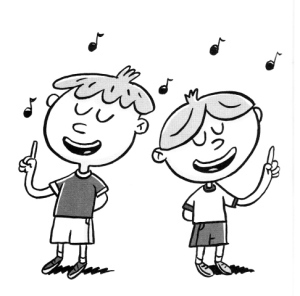
Orville & Wilbur singing (from SNARF ATTACK).
The books also contain what I call “moments of gratitude.” These are moments during which the boys are filled to the brim with appreciation for something– for each other, for their single mom, or for the beauty of the world around them. Why? Because I believe kids feel and take seriously those intense moments, and I want even my humorous books to ring true.
Here’s a moment from SNARF ATTACK when the boys head outside. It’s evening and their mom is practicing the cello.
The night was black and cold and silent, except for the crunching of our boots on the snow and the singing of the cello behind us, which sounded very far away. We walked to the middle of our backyard and stopped. Yesterday, and after school today, we had played in the front, so the snow back here was untouched.
Orville made a kind of gasp in his throat. “This is the best kind of snow,” he whispered. “The no-footprint kind.”
I nodded, and we looked at the world stretched out, glistening in the moonlight.
As an author of books for children and teens, I get fan mail that often brings me to tears. The letters that I’ve gotten from parents and kids about the Riot Brothers have provided me with some of my proudest moments.
My son didn’t like to read until he picked up the Riot Bros, now he can’t stop.
Orville and Wilbur have turned my non-reader into a reader.
When I read your book I laughed to the ground!
Would you please please write another one?
In that school library, I was receiving a very different kind of feedback and it got me thinking. I wondered why the father was so against the concept of silliness. I wondered if some people equate silliness with bad behavior and assume that children will “misbehave” if they read silly books. I wondered how many parents teach their children to judge books by their covers.
Currently, I have a new series called GOOD CROOKS. The books are about twins who have a deep and burning desire to do good deeds. The problem is they have parents who are infamous crooks; but the big hearts and strong moral compasses of the kids triumph every time and they manage to not only do good deeds, but also to thwart crime along the way. Will there be parents who refuse to let their kids read my new books, assuming that they are about kids who commit crimes and that their own children would become criminals if exposed to them?
All these thoughts were running through my head as the boy waited for my answer. Why do I write silly books?
“Because I think kids like them,” I said. “I wish your dad would read them.”
“Me too,” he said, and he walked out empty-handed.
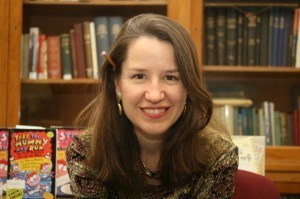
Mary Amato.
Mary Amato is an award-winning author of books for children and young adults. Many of her books have been translated into foreign languages and appeared on state reading lists. She teaches workshops on writing and is also a singer-songwriter. Her latest YA is called Get Happy and features songs on ukulele. She thinks it is hilarious when principals introduce her to students by saying, “Today, we get to meet a real, live author!” She is very happy not to be a fake, dead author. That would not be as fun. You can find her at www.maryamato.com or https://twitter.com/maryamato





September 23, 2014
Banned Books Month: Guest Post from Sarah Bromley: They Used to Burn Witches, Too.
“She seriously kept most of the YA books in their boxes and wouldn’t put them out for sale because she didn’t agree with the content in those books.”
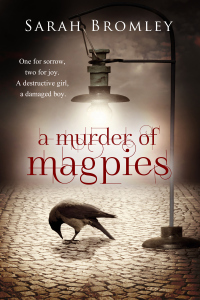
Month9Books, October 2014.
A YA author bit back her frustration when telling me about the person in charge of what books would be available at her child’s Scholastic Book Fair. The Scholastic Book Fair where, honestly, the books chosen are among the least controversial in any genre. It is an event I gladly volunteer to do at my own children’s schools because, hey, books and kids and getting books into kids’ hands, and isn’t that swell?
No, not really. It’s actually kind of complicated. You never know if the book you and your child love and you recommend to another mother is one that will make her clutch her pearls. Because a book about two penguins raising an egg can do that, if they’re both male.
Some people think that books are dangerous. Maybe it’s the ideas, the language (who hasn’t let a few bad words rip now and again? Even my sweet Baptist grandma let loose with a couple when she saw a mouse.), or something else altogether that rubs a reader so wrongly they think no one should read the offending book. That’s a rather Dark Ages approach to literature, isn’t it? You know, they used to burn witches, too.
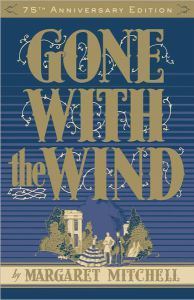
Scribner, Reissue Edition, May 2011.
I recall my first day in Ms. Judy Williams’ junior honors English course. “Every single book you are assigned to read this year has been banned.” Yeah, a bunch of so-called dirty ideas went through my head, wonderment about what stories possibly unfolded in the pages of a book. It was also the first time I was excited about having reading assignments in school. How could a story upset people so much that someone—even many someones—decided no one should be able to read that book? I eagerly gripped the pages of THE GREAT GATSBY and ALL QUIET ON A WESTERN FRONT, trying to figure out what was so wrong with them. “When we look at a list of books from the past that have been banned, banning them seems rather silly,” Ms. Williams recently wrote to me. “HUCKLEBERRY FINN, TO KILL A MOCKINGBIRD, GONE WITH THE WIND, all were banned because of racial language, but the books were against racism and used the language to make their point.” So often, it seems as if people wishing to ban books have missed the point.
How many books that are challenged or banned have gone on to become classic pieces of literature? It’s not the controversy surrounding them that turns them into classics. They are lauded and loved because they expose readers to new ideas, because they touch on some truth of the human experience with cutting precision. Perhaps they make readers uncomfortable, and it’s that very discomfort both drawing in readers and repelling them. Why, if a book makes you think too hard and isn’t merely a vehicle for enjoyment, it must be bad. Wrong. Immoral. It should be forgotten and kept away from others. Conversely, the book with a message can be studied, discussed, and the human experience shared and illuminated.
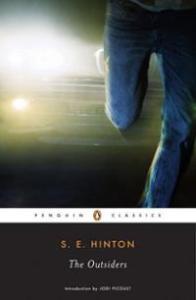
Penguin Classics, May 2006.
Do we want a world where Ponyboy didn’t stay golden and instead disappeared into dust? THE OUTSIDERS by S.E. Hinton was my ultimate go-to book for rainy days and feeling blue when I was younger. And there was violence, social classism, and death, but there was also some kind of hope, no matter how fragile it felt. Some readers need that.
Here’s the thing about banning books, doing so might make the person banning them feel better, but it also makes the book taboo. A taboo is alluring, which we know what happens when faced with that kind of temptation. Ms. Williams got my classmates interested in reading by waving that forbidden fruit before us. There is certainly a reaction to banning books that works in opposition to what the people wishing to censor the material hope to achieve—the books become more desirable, garner more attention, and are even more accessible in today’s digital age. While you still have teens passing around worn copies of books, they are just as likely to fire off a .PDF file to a friend.
I still talk to Ms. Williams. I can call her Judy now without it seeming weird. The discussion of banning books and “saving” young readers from so-called dangerous books comes up from time to time, and when I told her I was writing this piece and asked her thoughts, her response struck a chord with me. Judy wrote, “Most books are banned because people don’t agree with the message or dislike the language. The problem is that books are written for everyone, so to ban a book because it doesn’t fit someone’s sensibilities is to deny that book to everyone else … If you don’t like a book, don’t read it, but don’t take the opportunity away from someone else.”
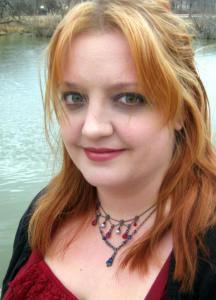
Sarah Bromley.
Sarah Bromley lives near St. Louis with her husband, three children, and three dogs. She likes the quiet hours of morning when she can drink coffee in peace, stare into the woods behind her house, and wonder what monsters live there. When she’s not writing or wrangling small children, she can be found volunteering at a stable for disabled riders. A MURDER OF MAGPIES (October 28, 2014, Month9Books, LLC) is her debut novel.





September 22, 2014
Banned Books Month: Guest Post from Tommy Hays: On Trial in the Library
I stood in front of the desk, as Mrs. Finley, my fifth grade teacher, who sat where the librarian usually sat, slid the check-out card in my direction.
“Did you write that, Tommy?”
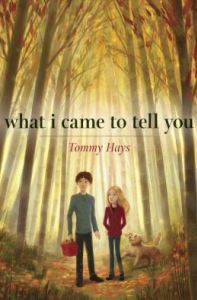
Egmont USA, September 2013.
Before I even read it, I knew something was wrong. Just a few minutes earlier Miss Watts, the school librarian, had come to our classroom door, and she and Mrs. Finley had whispered animatedly about something. Then Mrs. Finley, a usually warm, kind teacher, came up to my desk and in an icy tone asked that I come with her. I followed her down the hallway and around the corner to the school library, which was eerily empty, Miss Watts nowhere in sight.
The library had always been my refuge at Donaldson Elementary, the one place at school I felt at home, spending endless hours combing the biography section or sitting at a table reading about Robert E. Lee, Ulysses S. Grant, Betsy Ross, Jim Bowie, Daniel Boone, Eli Whitney, George Washington Carver, Clara Barton, Thomas Edison or Alexander Graham Bell. I loved losing myself in the company of these great men and women. And always after finishing one of these books, I felt a quiet sense of elation, that perhaps a little bit of their greatness might’ve rubbed off on me somehow. I was a shy, quiet, chubby, slightly depressive boy and these books always lifted my spirits and gave me something akin to hope.
So it was a shock to me to be in the empty library, a place I’d always felt welcomed, even supported, in front of a clearly agitated teacher. At the top of the card was typed John F. Kennedy and PT-109. It was a book I particularly loved and had checked out several times, reading and rereading, and it was a book I’d currently checked out yet again. But as I read down the list of names printed by the boys and girls who’d checked it out, when I reached the last entry there in smudged print was the word, “PUSSY”.
“Tommy?”
“Yes ma’am?” I said looking up from the card.
“I asked you a question. Did you write that?”
“No ma’am,” I said, my voice already trembling. At the time I had no clue that word meant anything other than cat, yet I knew from my teacher’s stony countenance that it clearly had another darker meaning. I told her I hadn’t written it but she kept after me, asking again and again. Finally I began to cry and Mrs. Finley said, “Well you’re certainly acting guilty.” I continued to deny it and she continued to grill me until she said that she would call my parents which I was grateful for because I knew they’d make clear to my teacher that I wouldn’t have done such a thing. Which they did. Mrs. Finley eventually apologized. It turned out that the library had two copies of JOHN F. KENNEDY AND PT-I09 and the librarian discovered the cards had been mixed up and my name was neatly printed on the other card.
In the end I was exonerated but it affected me for some time. And to this day, what I remember most about PT-109 is not the harrowing account of how Kennedy saved what was left of his crew after the PT boat he’d commanded had been torpedoed. What I remember is that single smudged word that looked as if the writer had pressed down hard, as if it had been shoved onto the library card.
Nearly fifty years later, I’ve found myself recalling that day in the library. I’m in trouble again. This time because of something I did write – a middle grade novel about a 12 year old boy, a coming of age story in many ways. One aspect of the boy in the book is that he’s becoming more conscious of his own sexual longings and the sexuality of the world around him. It’s really a very small part of the book, and the book contains only a few very tame references to this. Yet a few teachers have backed off from assigning the book because of those subtle references. I felt a little as if I was back in the library standing accused in front of Mrs. Finley.
However over time I’ve gotten a little perspective. I’ve come to realize how traumatized teachers and librarians are that they have to scour books for the least offending reference, lest they upset a parent, an administrator, a church leader or a politician. And who can blame those educators whose jobs are so precarious? Is it worth it to assign a book and risk angering a higher up, possibly even endangering one’s livelihood? Of course not.
So what’s a writer of children’s books to do? If our books have to fit neatly into certain moralistic strictures imposed by the culture, if we have to spend our time sidestepping or soft pedaling or out and out avoiding the hard things about being a child, then what sort of books are we writing? One thing I’m certain of. If my fifth grade self had come across my book on the Donaldson library shelf and read it, he would’ve felt comforted, consoled and emotionally met by the boy I portray in my novel. He would’ve been grateful and relieved to read about a boy who was feeling some of the strange, new, confusing things I myself was feeling.
What I’ve finally decided is this: As naïve and possibly even foolhardy as it may be in this contentious educational and political climate, children’s writers must, in spite of the ornery times we live in, write to the child and forget about all the adults reading over his shoulder.

Tommy Hays. (Photo by Michael Mauney.)
Tommy Hays is the Executive Director of the Great Smokies Writing Program and Lecturer in the Master of Liberal Arts program at UNC Asheville. He teaches in the MFA Creative Writing Program at Murray State University. A member of the National Book Critics Circle, he received his BA in English from Furman University and graduated from the MFA Program for Writers at Warren Wilson College. He lives in Asheville with his wife, Connie, and their two children, Max and Ruth.





September 19, 2014
Banned Books Month: Guest Post from William Ritter: Naughty Words and Critical Thinkers
In the back of my classroom, I have an old poster titled “How to Write the Perfectly Bad Essay.” It came with the room, a long list in a small font with no catchy pictures. None of my students gave it a second glance last year. This year, I mentioned it to my Literature class while going over course basics. “I haven’t read it,” I said casually, “but I’m told it has a naughty word on it—so I discourage any of you from looking at it.” By week two, no visual in my classroom had been as thoroughly examined as that poster.
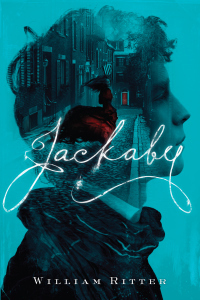
Algonquin Young Readers, September 2014.
Why would I set up students to disregard my suggestions like that? Because there is something I value even more than obedience—thought. I teach critical thinking skills—curiosity, evaluation of sources, examination of counter-arguments, articulation of original ideas. I want future generations who are capable of thinking for themselves, not just regurgitating information; capable of recognizing problems, not just accepting the status quo; capable of problem-solving, not just waiting for someone else to solve it for them.
Not everyone shares this mindset. Only two years ago a Texas-based political party wrote into its platform that they “oppose the teaching of Higher Order Thinking Skills… critical thinking skills and similar programs,” claiming that these skills “have the purpose of challenging the student’s fixed beliefs and undermining parental authority.”1 They OPPOSE critical thinking. I still have difficulty wrapping my brain around that statement as an educator.
They’re not wrong—critical thinkers challenge fixed beliefs. That’s the point. If we never challenged fixed beliefs, we would never have ended slavery, would never have won women the right to vote, would never have integrated public schools. It is vital that we challenge fixed beliefs from time to time, and I want to help raise a generation capable of doing so conscientiously.
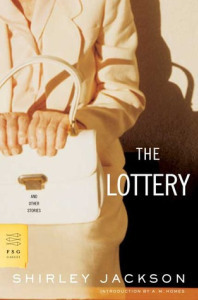
Farrar, Straus & Giroux, 2nd Edition, March 2005.
Students are smart. Mine are quick to understand concepts like censorship and indoctrination. The first short story I gave them this year was Shirley Jackson’s “The Lottery,” which depicts a surprisingly brutal tradition. Our first step upon finishing was to infer the author’s purpose. “Was she just trying to freak us out?” I asked. “Was she just a crazy woman with a typewriter? Why did she write this?” The very first student to raise her hand declared: “She wants you to think.” I am inclined to agree with her.
It’s no surprise to me that “The Lottery” is on the list of historically banned books (it was banned in South Africa during Apartheid). Books that encourage thinking are powerful things, and political groups that don’t want their fixed beliefs challenged have good reason to fear them. Books get banned because they don’t fall in line. “Some people even go so far as to consider prohibited or confiscated books to be the best ones of all, for the prohibition indicates that their authors wrote what they really thought rather than what they were supposed to think,” wrote Johann Lorenz Schmidt back in the 18th century.2
There are authors I agree with and those I vehemently oppose—books I love and books I hate. Learning to discriminate between these texts is part of developing a strong, critical mind and a sense of one’s own identity and personal values. It is for this reason I cannot fathom banning a book any more than I can wrap my mind around being opposed to critical thinking. And yet the practice continues. Unsurprisingly, banned books are predominantly children’s and teen titles—a demographic of developing minds with the dangerous potential to become… thinkers.
Last year’s top-10 list of banned/challenged books includes Dav Pilkey’s CAPTAIN UNDERPANTS, Sherman Alexie’s THE ABSOLUTELY TRUE DIARY OF A PART-TIME INDIAN, and Jeff Smith’s BONE (Frequently).3 These are books that have made countless readers (BONE helped make me a reader). Disenfranchised, struggling readers in my classroom have embraced Sherman Alexie so many times I had to retire one copy because it was tattered, stained, and falling to pieces, and another because it was stolen by a student who needed it. He admitted the theft later. He needed it because it was the first book that felt like it understood him. I could not fault him for the decision.
It is mortifying to imagine these books banned from the readers who need them. On the other hand, banning books has brought about one marvelously unintended benefit. “We haven’t read it,” the censors say, “but we’re told Toni Morrison’s THE BLUEST EYE has a naughty word in it—so we discourage any of you from looking at it.
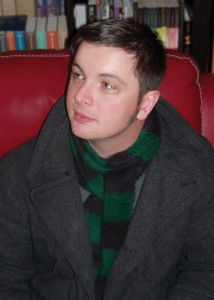
William Ritter.
William Ritter began writing JACKABY in the middle of the night when his son was still an infant. After getting up to care for him, Will would lie awake, his mind creating rich worlds and fantasies – such as the ones in New Fiddleham. Will lives and teaches in Springfield, Oregon.
Strauss, Valerie, The Texas GOP Rejects Critical Thinking. Really., Washington Post, 07/09/2012, http://www.washingtonpost.com/blogs/a..., Paul, Seize the Book, Jail the Author, Purdue University Press, 1998.Frequently Challenged Books of the 21st Century, ALA, http://www.ala.org/bbooks/frequentlyc....





September 18, 2014
Banned Books Month: Guest Post from Tracy Barrett: Censorship Inside Publishing
As far as I know, none of my books have been challenged—although more than one librarian has told me she couldn’t booktalk my middle-grade novel ON ETRUSCAN TIME because its twelve-year-old protagonist says “Damn” twice—but banning is only one kind of censorship. Some books don’t make it to the shelves, or even to the printer, before they’re shut down. That nearly happened to a project that was dear to my heart.
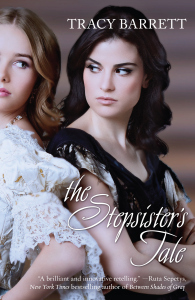
Harlequin Teen, June 2014.
I now write mostly young-adult historical fiction, but at the beginning of my career I concentrated on nonfiction for middle-grade readers. A highly-respected publisher was starting a new series and asked if any of the topics in its list appealed to me. When I saw that they wanted a book on the Indian Removal Act (the Trail of Tears), the forcible and brutal removal of large numbers of Native Americans from the southeastern United States to Oklahoma under orders of President Andrew Jackson, I leaped on it.
I live in Tennessee, through which many of these people were forced to travel (there was more than one “trail”), but my interest in this shameful episode in our nation’s history started long ago, when I learned that an ancestor of mine named Elizur Butler had served as a missionary and physician to the Cherokees in Georgia. He and the better known Samuel Worcester were imprisoned at hard labor for defending the rights of the Cherokees. They were pardoned but refused their pardons in order to force the case to the United States Supreme Court, which declared their imprisonment illegal. On his release, Butler accompanied the Cherokees on foot to Oklahoma, where he settled and served as professor of theology at the Cherokee Female Seminary, the first institution of higher education for women west of the Mississippi. His pardon, and Samuel Worcester’s, finally became effective in 1992.
So I felt a personal stake in the story, and researched it thoroughly and carefully before sending it to the publisher.
They liked the manuscript except for one thing: they told me that I had been too hard on Andrew Jackson, that the Indian Removal Act wasn’t out of line with the standards of the day, and that Jackson had merely been a man of his times. I protested, sending them copies of contemporary newspaper articles and editorial cartoons fiercely opposed to this action, and pointing out that the debate over the Indian Removal Act was the longest on record in the American Congress. The publisher still told me to soften my portrayal of Jackson. I refused, saying “genocide is genocide” and offered to cancel the contract and send them back their advance.
That was very, very hard. Finding someone to publish your manuscript is difficult, and this was a story I was eager to retell, with a publisher that produces beautiful books that receive awards and sell well. But I just couldn’t give in.
They returned my check, and shortly afterwards I was lucky enough to find another excellent home for the book. That publisher, Perfection Learning Corporation, sent the manuscript to a publicist at the Cherokee Nation for fact-checking. The publicist was complimentary about my research and how I had told the story, but she said that I had portrayed the Cherokees too negatively.
Déjà vu all over again!
I reminded my editor that one of the most tragic aspects of the way Native peoples have been treated is that they were relentlessly “Europeanized,” with their customs and culture stripped away from them. In a cruel twist, once that happened, their conquerors refused to accept them as fellow members of their own dominant society, leaving them with neither one nor the other. In showing the aspects of the pre-conquest Cherokee culture, I had to present the bad with the good (“bad” being defined in modern, European terms), and the fact is that the Cherokees were feared by their neighbors. They were, to our eyes, often brutal in warfare, burning captives alive and having their children pour water on the flames if the victim was dying too quickly. In at least one case, members of another tribe, realizing that they were about to be defeated by a band of Cherokees, committed mass suicide rather than face these fearsome enemies. (I didn’t go into such gory detail in the manuscript, but I alluded to these facts.)
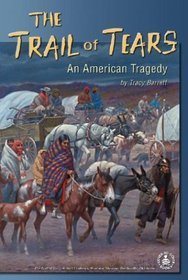
Jossey-Bass, June 2000.
Apparently the reader of the manuscript wanted me to cut out everything that looked bad to modern eyes, leaving the impression that the Cherokees inhabited a kind of Garden of Eden, living in peace and harmony with nature and with other people.
I refused to perpetuate this patronizing, “noble savage” view of the Cherokees and told my editor I wouldn’t make those cuts.
To her credit, she immediately agreed, saying that she had wanted me to be aware of the concerns of the outside reader and that as long as I had good documentation (I did), I was free to present this view.
Most nonfiction books for young readers go out of print quickly. THE TRAIL OF TEARS: An American Tragedy has been in print with Perfection Learning since 2000. I’ve never heard from any reader, Cherokee or Andrew Jackson fan, that one side or the other was presented unfairly.
Tracy Barrett is the author of numerous books for young readers, including the award-winning biographical novel, ANNA OF BYZANTIUM (Delacorte, 1999). Her most recent publications are a Cinderella retelling (THE STEPSISTER’S TALE, Harlequin Teen, 2014); two young-adult novels, DARK OF THE MOON (Harcourt, 2011) and KING OF ITHAKA (Henry Holt, 2010), and the four books in a middle-grade series, The Sherlock Files (Henry Holt). Nonfiction includes THE ANCIENT GREEK WORLD and THE ANCIENT CHINESE WORLD (Oxford University Press). Tracy was the Society of Children’s Book Writers and Illustrators’ Regional Advisor for the Midsouth from 1999 to 2009 and is now SCBWI’s Regional Advisor Coordinator. She was awarded the SCBWI Work-in-Progress Grant in 2005 and a grant from the National Endowment for the Humanities in 1994. She holds a B.A. with Honors in Classics from Brown University, and an M.A. and Ph.D. in Medieval Italian Literature from the University of California at Berkeley. She lives in Nashville, TN, where until recently she taught at Vanderbilt University.
Web site: www.tracybarrett.com
Facebook: https://www.facebook.com/TracyBarrettAuthor?ref=hl
Twitter: @writingtracy





September 17, 2014
Banned Books Month: Guest Post from Carrie Mesrobian: What is Graphic?
The other day I was on Goodreads, which I know, I know – authors should not look at their reviews there, or anywhere else – and there was a question a reader had posted in regards to my first book, SEX & VIOLENCE.
I should have walked away, but I didn’t. This was the question:
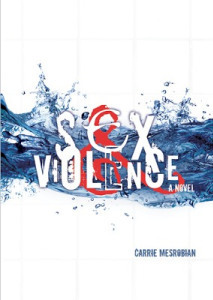
Carolrhoda LAB, October 2013.
Are the sex scenes graphic?
The word “graphic” is so loaded. I had no idea what the questioner was getting at.
Was he or she worried that the content would provide too much information? Or was she hoping it would? Because for me, often when people call something “graphic” they really mean that such things provide a data-rich environment in which to learn about something.
Graphic means you’re getting the whole picture. You’re seeing everything close-up, in color, three-dimensions.
For this reason, in my experience, most things I really want to learn about and understand are best if they’re given to me in “graphic” terms.
But I’m guessing the questioner meant “graphic” as in “too detailed” or with the dreaded prefix “porno” or something else that shrinks away from sex as it might occur between actual people and their actual bodies. Lots of people shrink away from such things, or want to shrink away from them, only to find themselves riveted and unable to look away. And when it comes to YA literature, they imagine a kid seeing this riveting, data-rich thing and not being able to look away, either.
And then what happens? The adult has to talk to the kid about sex! Or something else complex and discomfiting.
Thus, the cascade of book-banning events ensues. The book is challenged. The book is not purchased for a library collection or a gift. The book is taken off a list of recommended or assigned reading. All the overt forms of censorship we’re sadly used to seeing occur.
But I think there’s also a form of censorship that we don’t see. This occurs on the part of writers fearing such blowback – is this too graphic? is that okay for kids to read? – and so when it comes to writing sex or anything else controversial, they step back. The scene fades to black. The scene pivots and becomes a summary. The scene gets edited out. The end result is the reader doesn’t get to see that writer’s honest view of the world.
As a writer of YA fiction, this kind of pre-censorship is just as troubling to me as more classic forms of censorship and book-banning. Not only does it underestimate our audience’s capacity and disrespect their ability to select material that has meaning for them, but it also encourages writers to create a kind of pre-chewed, palatable and safe menu for readers, instead of offering up what might be an original view on a difficult or complicated topic. It makes decisions for readers we’ve never met. It contracts the limitless world of literature and all its ways of providing comfort, escape, meaning and empathy. It puts black bars over all the really interesting, important parts we want to see. It stands between readers and what they want to learn.
One dictionary definition of “graphic” as an adjective: “giving a clear and effective picture; vivid.”
Which is just like I want my writing to be. Words that make pictures behind our eyes. Words that tell stories and create ambience. Words that offer meaning and emotion.
For this reason, I want to live in a world where I can comfortably say, “yes, my book is graphic” and not feel bad about it. Because we already live in such a world: all around us is the undeniable truth about life and it is vivid, clear, effective. I can open my eyes; I can also shut them. May we always let readers make that choice for themselves as well.
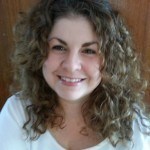
Carrie Mesrobian.
Carrie Mesrobian is an instructor at the Loft Literary Center in Minneapolis. Her debut novel, SEX & VIOLENCE, was called one of the best books of 2013 by Kirkus Reviews and Publishers Weekly and was a finalist for the American Library Association’s William C. Morris Award for best debut young adult novel. Her second book, PERFECTLY GOOD WHITE BOY, will be released October 2014. Visit Carrie online at www.carriemesrobian.com.





September 16, 2014
Banned Books Month: Guest Post from Len Vlahos: Two Stories, One Censor, and Hypocrisy
The proprietors of this wonderful site have been kind enough to ask me to guest blog about censorship. As I have yet to directly encounter a challenge to my book THE SCAR BOYS (though I did have one high school principal take exception to an event in which I was involved), I’m going to do what I do best, I’m going to tell you a couple of stories.
Story the First:
This story is about a mild mannered orphan who lives with his aunt, uncle, and cousin. He’s a nothing in their house, a nobody. The boy keeps to himself and tries to stay out of trouble until one day something magical happens. Literally.
The boy is visited by a kind of giant who says, “hey kid, did you know you have magical powers?”
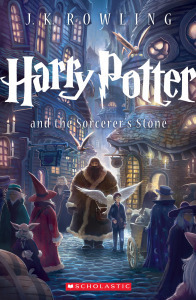
Scholastic, Reprint Edition, August 2013.
“Who, me?” the kid says. “You must have the wrong guy. I’m a nothing, a nobody.” “Not anymore. You’re invited to a school for wizards and witches. It freaking rocks.”
The boy says sayonara to the aunt, uncle, and cousin, and hops a train to the new school. But it isn’t all peaches and cream. Over and over again, the boy comes face to face with a great and powerful conjurer of the darkest sort. The conjurer is an authoritarian dill-hole who will stop at nothing to realize his maniacal quest for power, which for some reason includes a desperate need to kill the boy.
But the boy perseveres. He learns about friendship, honor, bravery, and love. Yes, the boy is a wizard, and yes, the boy practices magic. But he uses his magic for good. He finds inner strength, an inner angel if you will, and in the end (spoiler alert), he is literally prepared to sacrifice his own life to save the ones he loves.
The good guys are so easy to distinguish from the bad guys in this story that it’s almost embarrassing. But the book is so long on charm, and has so much heart, that you’d have to be half dead not to fall in love with it.
This first story is clearly labeled fiction, because you know, it’s not true.
Story the Second:
This is a story about a wild and crazy town where all the people—and I mean all the people—are nuts. Well, maybe nuts isn’t the right word. Let’s just say they’ve lost their way. These people put instant gratification on a kind of pedestal. They’ll do anything and everything they can for a good time. It’s kind of like Rocky Horror, or maybe the 1980s.
There is this one dude in town who doesn’t buy in. He’s a decent guy and he’s a family man. He’s the kind of guy you’d want handling your money. Anyway, two
magical warriors come to destroy the town, and they decide to crash at the house of the decent guy.
The instant gratification crowd, we’ll call them the instagrafs for short, are not happy about this. Their town is like Vegas, or maybe like Times Square before Disney and Foot Locker moved in, and they like it. They don’t need any carpetbaggers ruining the good thing they have going.
So an angry mob of the instagrafers goes to the nice guy’s house and they do this kind of we’ll-huff-and-we’ll-puff-and-we’ll-blow-your-house-down thing, commanding the nice guy to send the magical warriors out.
“Hey,” the nice guy says to the mob, “what kind of host would I be if I just turned these guys over to you? No one would ever come to visit me again. I mean, would any of you?”
“Whatever, dude,” they say, “just give us the magical warriors. We want to have some fun with them, if you know what we mean.”
“I have a better idea,” the nice guy says. “Check out my two daughters, they’re like totally hot, and get this, their both virgins. Take them and do with them as you please. Just leave my houseguests alone, okay?”
Before the nice guy can complete the transaction, before he can turn his own daughters over to the ravenous, depraved mob—his own daughters for crying out loud!—the magical warriors pull him back into the house.
For some reason, instead of being skeeved that the guy was willing to give his daughters to an angry mob, the warriors are kind of flattered. “Okay nice guy,” they tell him, “we’re going to lay waste to this city tomorrow. I mean, we are going to burn the ever-loving crap out of it. Take your wife and daughters, and high tail it out of here. Go to the mountains. You’re not going to want to see this.”
So the next morning the nice guy gets his wife and daughters together and heeds the advice he’s been given. Some juju that’s too weird to try to explain happens to his wife and he has to leave her behind, so he and the daughters go to the mountains alone. As they flee, the city and everyone in it is completely destroyed. Men, women, and children are burned alive. (Imagine having acid poured on you while hot rocks are dropped on your head. That crap just doesn’t happen, not even in Vegas.)
Finally, the nice guy and his two hot daughters make it to a secluded cave. The guy is distraught and worn out (he’s kind of old to begin with), so he crashes, hard. The older daughter is like, “hey, you know what? Everyone and everything we know has been wiped out. We need to keep our family name going, so let’s have sex with dad.”
(Wait, what? Sex with their dad??? Yes, that’s really what happens in this story. )
“Cool,” says the younger daughter, “but let’s get Dad drunk first, okay?” So they do. And they do.
Nine months later each daughter gives birth to a child—miraculously the children suffer no genetic maladies—and two great nations of the ancient world are founded.
There is actually a debate as to whether this story is fiction or not. (I don’t partake in this debate, because, you know, it’s fiction.)
So those are my two stories. What do you think?
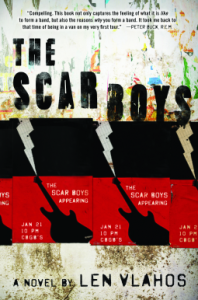
Egmont USA, January 2014.
The first, Harry Potter of course, was one of the most banned books from the decade of the 2000s. The second is a pretty faithful retelling of Genesis 19 from the Bible (the story of Lot and the cities of Sodom and Gomorrah). This very same Bible is the book many people use as justification for banning books like Harry Potter. “Don’t teach my kid about witches! Jesus would object. Teach her about cruelty, revenge and incest instead, okay?” (One nutbag pastor in New Mexico went so far as to hold a good old fashioned Harry Potter book burning, you know, just like the Nazi’s used to do.)
So which story would you rather have your kids read? The one where the good and wholesome orphan defeats the bad wizard, or the one that ends with daughters raping their own father?
Well, here’s the thing about censorship and reading choices:
I don’t give a good goddam which book you want to read, or which one want you want your kids to read. That’s your business. If you want to read the Bible with them, good for you. If you want to read Harry Potter with them, good for you. Just read to them, and talk about what you read, okay?
But don’t ever tell me which one of these books I, or my kids, get to read, and definitely don’t tell my school library which books they’re allowed to shelve. Understand? Because if you do, and especially if you use the Bible—a book so replete with sex and violence that it will curdle your blood—as a justification for censorship, you’re nothing but a low-down, no good hypocrite.
Amen and over and out.
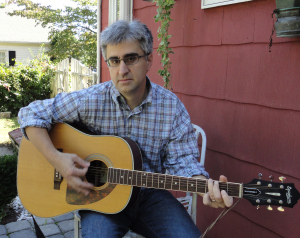
Len Vlahos.
Len Vlahos is the Executive Director of BISG, and the former COO of the American Booksellers Association, where he worked for the past 20 years. At the ABA, he had overall responsibility for ABA’s Winter Institute. So he knows booksellers and booksellers know him. Len has also worked in indie, chain, and university bookstores, was an on-air personality for a commercial radio station in Atlantic City, and worked for a time for Internet marketing guru Seth Godin. He was in a punk rock band in the mid-1980s. The Woofing Cookies toured and their music was played on dozens of college radio stations coast to coast. Find Len on Twitter: @LenVlahos.





September 15, 2014
Banned Books Month: Guest Post from Meghan Marentette: Go Ahead, Ban That DEPLORABLE Book!
You could say I have an outsider’s point of view. When I was in school in the 80s, I don’t remember a single teacher or parent who challenged the existence of a book in a curriculum. Books were easily accessible, and in those days, school libraries were full of books! (Now many seem so sadly underfunded). My parents were liberal thinkers, my teachers on their way to it, and my city of Halifax had a burgeoning arts community, to which I was destined to belong. Life was on track to become well-rounded, and fulfilling.
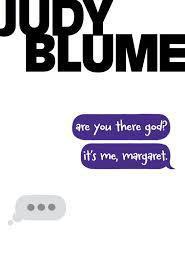
Atheneum Books for Young Readers, Reprint Edition, April 2014.
So at age 12, rather innocently, I borrowed Judy Blume’s ARE YOU THERE GOD? IT’S ME, MARGARET, endorsed by my junior high librarian, without any clue that in places southwest of here, it was considered a misguided piece of trash. To me, it was a fun read that confirmed my pubescent thoughts were common and normal. I was unaware there was any conflict about its publication, or the fact that I had access to it. No one said anything about that.
Meanwhile, in other towns, girls were having their purity unpeeled just by reading Judy Blume. By the steady gavel of judgment, they learned what shame was, before I knew it existed.
In high school, I read THE CATCHER IN THE RYE as part of the curriculum without the slightest notion that its contents were offensive. Would Holden Caulfield muster up the energy to murder the next “phony” he met? Well, that didn’t really occur to me; my reading skills weren’t the best in comprehension at age fifteen. And I certainly don’t remember my teacher drawing attention to a dark side of his character, as if he was out of line with normal teenage thought. But if Holden did gun down the “phonies”, would I have been influenced to do the same, feeling similarly that there were people in my realm I didn’t trust? Um, no. It was a book. Of fiction. That I had to read. For school.

Little, Brown and Company, Mass Market Edition, May 1991.
But meanwhile, there were teenagers in other towns who, under iron fist, learned such literature could turn them into killers if they let Salinger warp their malleable, baby brains. Ah, the irony. (Maybe it did provide a bizarre rationale for a few demented adult minds to kill, but we can’t judge that a book has that much power when the other 65 million people who read it didn’t pick up a gun.)
But I can’t say I feel like I had a better education than these other girls and boys, despite my schools being open to all literature, and their schools frantically screening all written word. Maybe school was calmer for me, but then maybe those kids learned more about human nature by living under the thumb of it, than I did by reading about it. Sometimes a little clashing of the minds is necessary to get the brain bubbling and the feet in motion.
Contrast is a necessary part of education. How do we know one point of view suits society beneficially, if we aren’t aware of another point of view, to which we have unfettered access? How can we imagine that if we discourage critical discussion among young minds, we can expect them to make informed decisions as adults? If we don’t discuss unhappy thoughts, or ‘negative’ ideas, how can we really understand what a positive thought or action is?
This is the belief of liberal schools who don’t ban books. They let it all hang out there, and teach tolerance to the nth degree. And it works, sure. My classmates and I are all ‘big picture’ thinkers now. Adults who respect our neighbours and spay our kittens. We pay our taxes and watch The Daily Show. We welcome immigrants and we learn their recipes. We sign a lot of petitions from our computer chairs, in concern for the oceans and slave labour. You’re gay? That’s nice.
But when I think about an effective education, one that challenges people to get up out of the chair and go to that protest march and demand change, I think it goes well beyond a liberal curriculum supported by contrasting thought. It comes from being faced with actual conflict.
I think about the girl, only three years ago, whose undisclosed school produced a list of 120 books forbidden to its students. So what did she do? She managed a library of 60 of those banned books out of her school locker. When I heard about it, I felt excited for her. She insisted on a complete education, and got one by her own means, without letting her elders define what’s ‘important’. She learned to act.
Because her school brought attention to those books in a negative way, not only she, but many of her school mates, wanted to read them, and pursued reading. After all, what teenager won’t try the exact thing you tell them not to do? Gaggles of students must have texted each other under their desks: “What’s inside those secret pages that could foul us up as human beings? Let’s find out!” And in so doing, they questioned their education and learned to analyze literature, when otherwise they might have been dreaming of Bieber.
I’m not saying we should ban books merely to draw attention to them―that would be more transparent than twenty-year-old underwear! And I’m not even sure it’s relevant to ban a book anymore, what with the internet and all (it’s easy to order a banned book, or study reams of forum chat about its content). Let me be clear, I do not support the banning of books―how could I, when I am one of the students who benefitted by reading them? (Let me also be clear that I am addressing the banning of books to teens in wealthy, democratic societies―lack of access to books and education in general is an entirely different discussion).
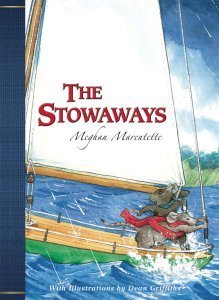
Pajama Press, April 2014.
But I do wonder deeply about the efficacy of my own even-keeled education. I wonder if, because I grew up in schools where nothing was challenged, I became a lazy student. I took for granted that my education was complete and I ‘knew it all’, which, of course, I did not. Where were the heated discussions that would lead me to question my world? In another town, I guess. I wonder how much longer it took me to grow up―to realize that my life, and my education, was mine for the making―when whatever I ‘needed to know’ to become a well-rounded person was handed to me. Where was my motivation to search for the truth?
In many ways, I wish I had been more involved in my own education. By grade 12, I was skipping a lot of school and still making As. School was way too easy, at least in the 80s. Maybe it’s crazy to wish for more turmoil in my teen years when there was plenty of self-induced conflict. But maybe, or very likely, clashes of ideology in the classroom would have been better for my personal growth than the conflict I sought out in relationships instead, and would take years to get over.
The act of banning books is appalling at face value. But let’s consider how it brings up a valuable discourse that might not take place otherwise. The more an ideology goes unchallenged, the less it is understood. If I wrote a book that had all nice characters who accepted each other for who they are, and everyone got along famously, would you read it? No. Would your kids learn anything from it? No. They might live in a world where everything is perfect and tolerant and nice, but then what happens one day when someone does something that doesn’t jive with their ideal? They freak out, like I did. And maybe they can’t find a solution without feeling personally rejected. Life might feel harder for them than you wanted.
After decades of growing up, perhaps very late, I finally started to write. And what do I write about? Conflict! I crave it. My favourite characters to write are the messy ones. Gran is moody. She’s rude. She never explains herself. And my readers love her.
So maybe I can’t complain about my ‘sleepy’ education either, if it eventually led me to write with passion. I’m just saying, when a book is banned, it’s not necessarily a bad thing. It could actually provide an opportunity for an otherwise unchallenged child to question her values sooner, and learn that disagreements are a workable situation. And isn’t that the best education a child can get?

Meghan Marentette.
Meghan Marentette is the author of THE STOWAWAYS, a middle-grade novel about a young mouse who finds plenty of conflict when he challenges the narrow horizons of his childhood. Inspired by a job making tiny costumes for stop-motion animation puppets, THE STOWAWAYS has been nominated for the CLA Book of the Year for Children Award, the Monica Hughes Award for Science Fiction and Fantasy, and the Ann Connor Brimer Award. Meghan continues to write and design costumes for film and television in Halifax, Nova Scotia.






